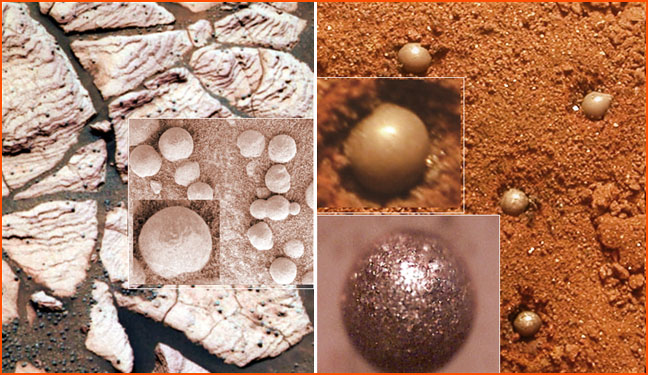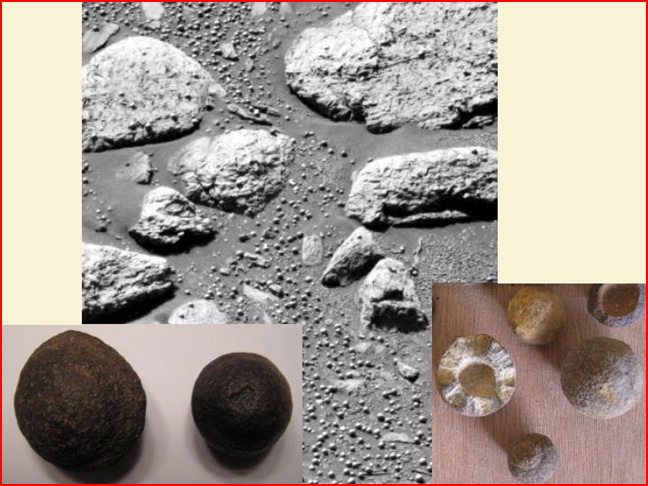
Left Image Source: NASA ---- Right Image Source: CJ Ransom, of Vemasat Laboratories
Posted on 03/28/2005 9:58:11 PM PST by Swordmaker
Plasma physicist uses electric arcs to replicate the mysterious spherules on the Red Planet.
On January 25, 2004, the Mars Rover “Opportunity” landed in a small crater on the Martian plain called Meridiani Planum. A few days later, Opportunity photographed a sight that could alter our ideas about the recent history of the solar system: Scattered around the walls of the crater were BB-sized spherules. Their blue-gray color set them apart from the reddish hue of the iron-rich Martian soil and suggested a name for them—blueberries.

Left Image Source: NASA ---- Right Image Source: CJ Ransom, of Vemasat Laboratories
The left half of the picture above shows these Martian blueberries at different magnifications. They are embedded in what appears to be fused layers of soil that are exposed on the margins of the crater.
As Opportunity rolled further across the Martian landscape, it found a profusion of blueberries. Investigative team members speculated that countless numbers of the spherules lie embedded in the Martian soil. Over time, erosion has exposed large numbers of them and has left many lying on the surface.
After spectroscopic analysis, the Martian spherules were identified as “hematite concretions”. Hematite is an iron-rich mineral and is the primary constituent of the soil surrounding the blueberries. Geologists surmised that they are Martian counterparts of terrestrial concretions, which are commonly believed to have formed through water-induced mineral leakage. But this only widens the mystery. Theories about the formative processes of concretions are little more than untested guesses. No geologist has seen a concretion being made or has made one in a laboratory—or has disproved a competing theory. (But geologists have shown that the more a guess is repeated, the more it’s apt to be called a fact.)
For many years Electric Universe theorists have proposed that concretions be examined for evidence of formation through electric discharge. In our Picture of the Day for August 27, 2004, Blueberries on Mars, we compared the Martian spherules to hematite concretions from Texas and “Moqui balls” from Utah. We gave several reasons for investigating the possible electrical origins of concretions, geodes, and other mysterious spherical geologic forms.
The conventional theories, we noted, are based exclusively on chemistry and mechanics. But there is another phenomenon that produces spheres—electric discharge. In the plasma lab, electric arcs create tiny spheres that are often hollow, such as the hematite concretions seen above. Electric discharge tends to produce spherical layering and a distinct equator and pole, because the electromagnetic force "squeezes" perpendicular to the current that creates it. These characteristics are also found in the "natural" spherules. The Moqui balls pictured here (lower left)

have both equatorial bulges and polar markings. Rock-cutters recommend that you will get a better display from a geode if you first locate the equator and poles, then cut across the poles.
Even before this Picture of the Day was written, the plasma physicist CJ Ransom, of Vemasat Laboratories, had set up an experiment to test the electrical explanation of concretions and Martian blueberries. He obtained a quantity of hematite and blasted it with an electric arc. The results are seen in the right half of the image above. The embedded spheres created by the arc appear to replicate many of the features of the blueberries on Mars. No other laboratory process has achieved a similar result. It should encourage further experiments using higher energies.
Dr. Ransom’s experimental work has laid a foundation for a radical reassessment of planetary geology. If concretions can only be replicated by electric discharge, we can no longer view them—or the strata in which they appear—through the lens of prior theory. (See tomorrow’s Picture of the Day for more on concretions.)
In the matter at hand (hematite concretions), the direct evidence will be difficult to ignore. Dr C.J. Ransom's and Wallace Thornhill's paper on the laboratory-generated spherules will be presented at the national meeting of the American Physical Society, in Tampa Florida, April 17, 2005. The abstract is available at the APS web site--
Electric Universe PING!
Thanks!
Disclaimer: Opinions posted on Free Republic are those of the individual posters and do not necessarily represent the opinion of Free Republic or its management. All materials posted herein are protected by copyright law and the exemption for fair use of copyrighted works.